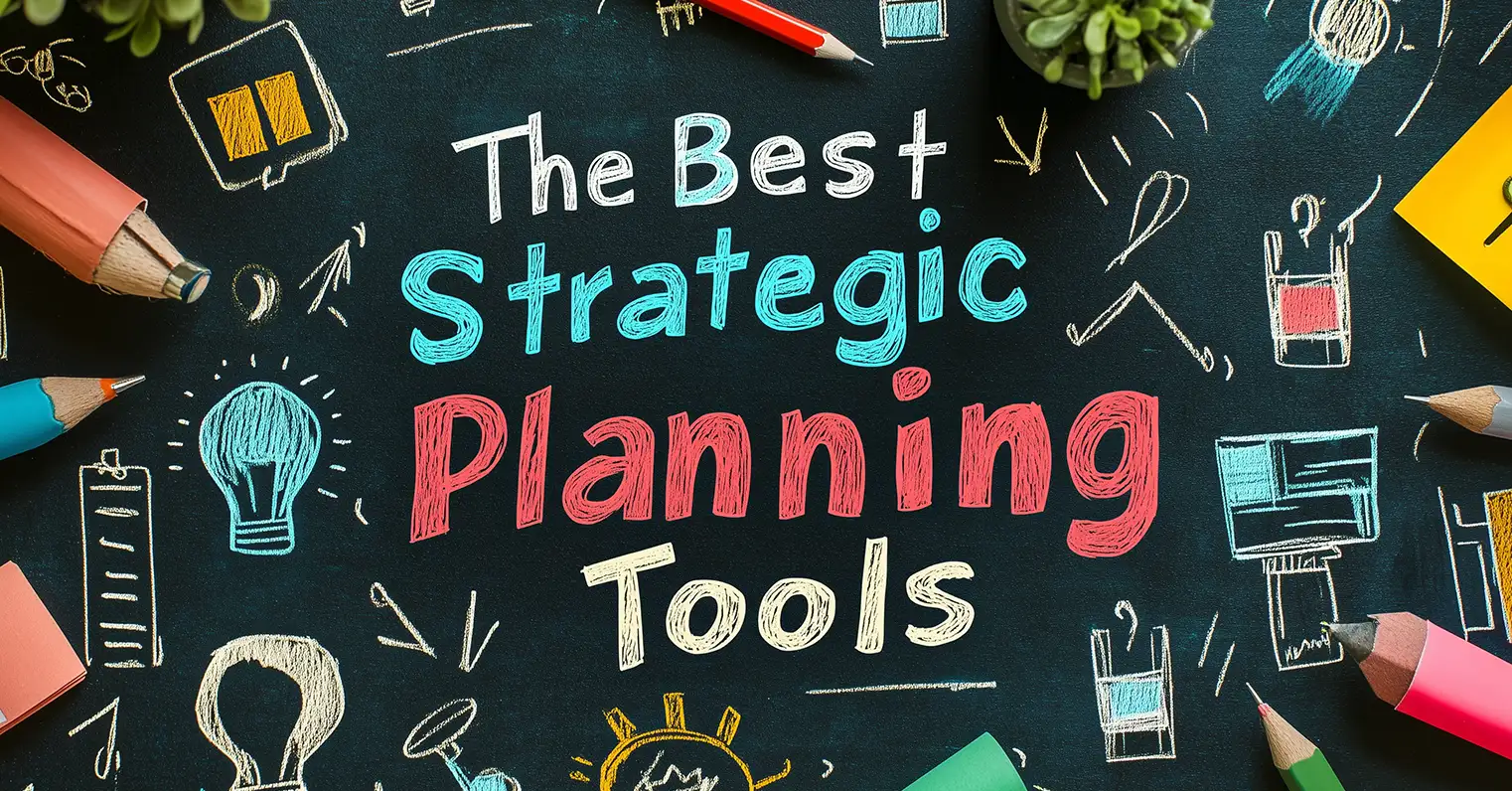Understanding the VRIO Framework for Competitive Analysis

Leveraging your company's unique resources is essential for lasting success. The VRIO Framework is a key tool in this process, helping you identify and maximize the strengths that give your organization sustainable competitive advantages.
By understanding the core elements of the VRIO Framework, you can enhance both your strategic planning and decision-making. This article explores how to effectively apply VRIO, offering practical insights to help integrate it into your business strategy.
Main Takeaways From This Article:
- The VRIO Framework is essential for identifying and leveraging rare and valuable resources that can provide a sustained competitive advantage.
- A sustained competitive advantage arises from resources that are valuable, rare, difficult to imitate, and well-organized.
- VRIO Analysis guides strategic decision-making by helping organizations focus on resources that are most likely to yield long-term success.
- Integrating VRIO Analysis into strategic planning ensures that resources are aligned with organizational goals and objectives and continuously monitored for effectiveness.
- Spider Impact software can enhance the implementation of VRIO Analysis by tracking performance and aligning resources with strategic objectives.
What Is the VRIO Framework?
The VRIO Framework is a strategic tool organizations use to assess their internal resources and capabilities. VRIO stands for Value, Rarity, Imitability, and Organization—four criteria that determine if a resource can offer a sustained competitive advantage.
- Value: Does the resource help the organization exploit opportunities or defend against threats? A valuable resource boosts efficiency and effectiveness, directly impacting overall performance.
- Rarity: Is the resource unique or scarce in the industry? If it's rare, it can offer a competitive edge. If not, it may only lead to a competitive disadvantage, where no company gains a significant edge.
- Imitability: How easily can competitors replicate the resource? If it's hard or costly to imitate, it's more likely to sustain a long-term advantage. Easy-to-copy resources, however, lead to only a temporary edge.
- Organization: Is the organization structured to fully leverage its valuable, rare, and inimitable resources? Even the best resources won't provide an advantage if the organization isn't equipped to use them effectively.
Sustained vs. Temporary Competitive Advantage
Understanding the difference between sustained and temporary competitive advantage is key to effective strategic planning.
- Sustained Competitive Advantage: This occurs when a company has resources that are valuable, rare, difficult to imitate, and well-organized. These resources help the company maintain its edge over competitors for a long time, leading to lasting success.
- Temporary Competitive Advantage: This happens when a resource is valuable but either common or easy to replicate. While it offers a short-term boost, the advantage fades quickly as competitors catch up.
To achieve long-term success, focus on developing and protecting resources that are not only valuable and rare but also hard for competitors to imitate and fully integrate into your organization's strategy. This approach is crucial for staying ahead in a competitive market.
Why Is VRIO Analysis Important?
In a fast-changing market, understanding what sets your organization apart is key to maintaining a competitive edge. Here's why VRIO Analysis matters:
- Identify Competitive Advantages: The VRIO Framework helps companies pinpoint which resources truly give them an edge. It distinguishes between resources that merely support operations and those that drive success.
- Optimize Resources and Capabilities: VRIO Analysis enables businesses to focus investments on the most valuable and rare resources. This targeted approach ensures that time, capital, and talent are allocated where they'll result in the greatest competitive parity.
- Make Strategic Decisions: Understanding your resources through the VRIO lens leads to better strategic planning. Whether entering a new market, launching a product, or defending against competitors, knowing which resources to leverage can be the difference between success and failure.
- Maintain a Sustainable Competitive Advantage: The goal of VRIO Analysis is to achieve a sustained competitive advantage that's hard for competitors to replicate. Focusing on resources that are valuable, rare, difficult to imitate, and well-organized helps maintain an edge, even in challenging environments.
- Improve Organizational Alignment: VRIO resources also help with internal analysis to highlight inefficiencies. By identifying underutilized or poorly organized resources, businesses can make adjustments to improve alignment and overall performance.
Situations Where VRIO Analysis Is Most Beneficial
VRIO analysis is particularly valuable in several key business scenarios:
- Strategic Planning and Competitive Positioning: When developing or revising a strategic plan, VRIO Analysis helps identify resources that can provide a sustainable competitive advantage. This insight is crucial for deciding where to allocate resources, which markets to enter, and how to position the company against competitors.
- Mergers and Acquisitions: During mergers and acquisitions, VRIO Analysis is used to assess the value of a target company's resources. It determines whether these resources add significant value, are rare, difficult to imitate, and can be effectively integrated into the acquiring company. This ensures that the acquisition strengthens the company's competitive position.
- Product Development and Innovation: When launching new products or services, VRIO Analysis helps determine if the resources behind these innovations will yield a competitive advantage. For example, a unique technology or patent that is valuable, rare, and hard to replicate can provide a strong foundation for a successful product launch.
- Crisis Management and Turnaround Strategies: In times of crisis or market disruption, businesses need to quickly identify which resources can stabilize operations and drive recovery. VRIO Analysis helps focus efforts on the most critical and strategically valuable assets.
- Operational Efficiency Improvements: For companies seeking to enhance operational efficiency, VRIO Analysis can highlight underperforming or underutilized resources. By focusing on resources that meet the VRIO criteria, organizations can improve productivity and reduce costs.
Step-By-Step Guide to Performing a VRIO Analysis
Let's break down a VRIO Analysis step by step:
Value: Assessing Valuable Resources
Start by evaluating whether a resource or capability is valuable. A resource is valuable if it helps your organization capitalize on opportunities or neutralize market threats. To assess value, ask:
- Market Relevance: Does the resource enhance your ability to meet customer needs or improve market position?
- Operational Impact: Does it increase efficiency, reduce costs, or improve quality?
- Strategic Alignment: Is it aligned with your overall strategic goals?
If a resource meets these criteria, it can form the foundation for a competitive advantage. If not, it may need reallocation or divestment.
Rarity: Identifying Rare Resources
Next, determine if the resource is rare—meaning it's not widely possessed by competitors. Rarity is crucial for differentiating your organization in the market. To evaluate rarity, ask:
- Market Uniqueness: How common is this resource in your industry? Do few competitors possess it?
- Scarcity: Is it difficult for others to acquire or develop?
- Competitive Differentiation: Does it provide a distinctive advantage?
If a resource is both valuable and rare, it has greater potential to create a competitive edge. If it's common, consider ways to make it more unique, like enhancing its features or combining it with other resources to create a new, differentiated offering.
Imitability: Evaluating the Cost to Imitate
Assess how easily competitors can replicate the resource. The harder and more costly it is to imitate, the stronger your competitive advantage. Consider:
- Complexity: Is the resource complex and hard to reproduce?
- Historical Development: Does it have a unique history or development path that's difficult to copy?
- Legal Protections: Are there patents or trademarks preventing replication?
- Cost: How expensive would it be for competitors to develop a similar resource?
Resources that are valuable, rare, and difficult to imitate are key to long-term competitive advantage. If easily imitated, look to innovate or combine it with other resources to create stronger barriers to competition.
Organization: Leveraging Resources Effectively
Finally, evaluate whether your organization is structured to fully leverage its valuable, rare, and inimitable resources. Even strategic resources won't provide a sustained advantage if not used effectively. To assess this, ask:
- Management Systems: Are systems in place to fully exploit the resource?
- Processes and Policies: Do processes ensure the resource is used to its maximum potential?
- Cultural Alignment: Does the culture support the effective use of the resource?
- Infrastructure: Is the necessary infrastructure (technology, personnel, etc.) in place?
If your organizational structure is well-positioned to leverage its resources, it can significantly contribute to sustained competitive advantage. If not, consider investing in organizational improvements to better utilize your strategic assets.
Integrating VRIO Analysis Into the Strategic Planning Process
Here's how to effectively integrate VRIO Analysis into your strategic management process:
1. Initial Assessment and Resource Inventory
Start by thoroughly assessing your organization's resources and capabilities. This includes both tangible assets (like technology, finances, and infrastructure) and intangible ones (like brand reputation, intellectual property, and culture). Use the VRIO Framework to evaluate each resource's value, rarity, imitability, and your organization's ability to leverage it.
2. Aligning Resources with Strategic Goals
Next, align the resources that meet the VRIO criteria with your strategic goals. Determine how each resource can support specific objectives within your strategic plan. For instance, if a technology is valuable and rare, leverage it to drive innovation or enter new markets.
3. Strategic Prioritization and Resource Allocation
Use VRIO Analysis to prioritize strategic initiatives based on your strongest resources. Focus on resources that are valuable, rare, and hard to imitate. Allocate budget, personnel, and time to ensure these resources are fully utilized.
4. Monitoring and Continuous Improvement
VRIO Analysis should be an ongoing part of your strategic planning. As markets evolve, revisit your VRIO Analysis to ensure your strategies remain relevant and your resources are effectively leveraged.
Limitations of The VRIO Framework
While the VRIO Framework is a valuable tool for assessing and leveraging resources, it's important to recognize its limitations:
Internal Focus
The VRIO Framework primarily focuses on internal resources and capabilities, potentially overlooking external factors like market dynamics, competitor actions, or customer preferences. Relying solely on VRIO may result in an incomplete strategic picture.
Subjectivity in Assessment
Evaluating resources against the VRIO criteria can be subjective. What one person considers valuable or rare might not be viewed the same way by others, leading to inconsistencies in analysis and decision-making.
Static View of Resources
The VRIO Framework tends to assess resources at a single point in time, which can be limiting in fast-changing markets. Resources that are valuable today may not hold the same value in the future as industries evolve and new competitors emerge.
Complexity of Implementation
Identifying and categorizing resources as valuable, rare, inimitable, and well-organized requires deep organizational knowledge and can be complex. Smaller organizations with limited resources may find it challenging to apply the framework effectively.
Overemphasis on Sustainable Advantage
While sustaining a competitive advantage is crucial, the VRIO Framework may overemphasize long-term advantages at the expense of agility and innovation. In rapidly evolving industries, companies also need to be adaptable and responsive to change, not just focused on maintaining a static advantage.
Resource Interdependence
The VRIO Framework evaluates resources individually, which can overlook how resources interact with each other. Some resources may only create a competitive advantage when combined with others, and this interdependence isn't fully captured by the framework.
Recognizing the VRIO Framework's limitations allows you to apply it more judiciously within the broader context of your strategic planning. For instance, by complementing VRIO with tools like SWOT analysis, PEST analysis, or Porter's Five Forces, you can gain a more well-rounded understanding of both internal and external factors that impact your business. These additional tools can help fill the gaps that VRIO might leave, such as evaluating market trends, customer behaviors, and competitor movements.
Incorporating multiple perspectives ensures that you're not just focusing on the strengths and weaknesses within your organization but also on the opportunities and threats in the external environment. This holistic approach helps you anticipate changes, adapt to new challenges, and seize emerging opportunities, all while leveraging your internal resources effectively.
Achieve Sustained Competitive Advantage With Spider Impact
Understanding and applying the VRIO Framework is crucial for identifying and leveraging resources that can drive sustained competitive advantage. To make the most of this powerful tool, consider integrating it with Spider Impact. Our platform not only aligns your strategic initiatives with key resources but also continuously monitors performance, ensuring your organization remains adaptable in a competitive landscape. By centralizing your performance data, Spider Impact simplifies the process of strategic planning, helping you focus on what truly drives success.
Ready to see how Spider Impact can enhance your strategic planning? Book a live demo today and take the first step toward sustained success.
Frequently Asked Questions
What is the VRIO Framework and why is it important?
The VRIO Framework is a strategic tool used to assess an organization's internal resources and capabilities. It stands for Value, Rarity, Imitability, and Organization. The framework is important because it helps companies identify and leverage rare and valuable resources that can provide a sustained competitive advantage. By evaluating resources against these four criteria, organizations can focus on developing and protecting assets that are most likely to yield long-term success and guide strategic decision-making.
How does the VRIO Framework differentiate between sustained and temporary competitive advantage?
The VRIO Framework differentiates between sustained and temporary competitive advantage by evaluating resources based on their value, rarity, imitability, and organizational support. A sustained competitive advantage occurs when a company has resources that are valuable, rare, difficult to imitate, and well-organized within the company structure. These resources help maintain an edge over competitors for an extended period. In contrast, a temporary competitive advantage arises when a resource is valuable but either common or easy to replicate, offering only a short-term boost before competitors catch up.
In what situations is VRIO Analysis most beneficial?
VRIO Analysis is most beneficial in several key business scenarios. These include strategic planning and competitive positioning, where it helps identify resources that can provide a sustainable advantage; mergers and acquisitions, to assess the value of a target company's resources; product development and innovation, to determine if new products or services will yield a competitive edge; crisis management and turnaround strategies, to quickly identify critical resources for recovery; and operational efficiency improvements, to highlight underperforming or underutilized resources that can enhance productivity and reduce costs.
How can organizations integrate VRIO Analysis into their strategic planning process?
Organizations can integrate VRIO Analysis into their strategic planning process by following several steps. First, conduct an initial assessment and resource inventory, evaluating both tangible and intangible assets using the VRIO criteria. Next, align the identified VRIO resources with strategic goals, determining how each can support specific objectives. Then, use the analysis for strategic prioritization and resource allocation, focusing on the strongest VRIO resources. Finally, implement ongoing monitoring and continuous improvement, regularly revisiting the VRIO Analysis to ensure strategies remain relevant and resources are effectively leveraged as markets evolve.
What are the limitations of the VRIO Framework?
The VRIO Framework has several limitations. It primarily focuses on internal resources, potentially overlooking external factors. The assessment can be subjective, leading to inconsistencies. It provides a static view of resources, which can be limiting in fast-changing markets. Implementation can be complex, especially for smaller organizations. The framework may overemphasize sustainable advantages at the expense of agility and innovation. Lastly, it evaluates resources individually, which can overlook how resources interact with each other to create competitive advantages. Recognizing these limitations allows for more judicious application within a broader strategic planning context.
Demo then Free Trial
Schedule a personalized tour of Spider Impact, then start your free 30-day trial with your data.






